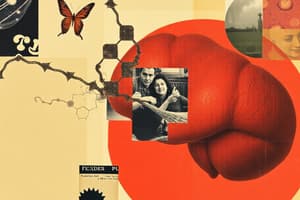Podcast
Questions and Answers
A new drug is designed to mimic a specific hormone. If this drug successfully activates the target cells, which of the following cellular responses is most likely to occur?
A new drug is designed to mimic a specific hormone. If this drug successfully activates the target cells, which of the following cellular responses is most likely to occur?
- Inhibition of metabolic pathways by directly binding to enzymes.
- Increased synthesis of proteins due to activation of genes. (correct)
- Decreased levels of cAMP within the cytoplasm.
- Increased breakdown of the hormone through positive feedback mechanisms
If the hypothalamus is damaged, which function would be most severely affected?
If the hypothalamus is damaged, which function would be most severely affected?
- Maintenance of body temperature and regulation of pituitary gland activity. (correct)
- Control of heart rate and blood pressure.
- Regulation of blood glucose levels by releasing insulin.
- Production of thyroid hormones.
A man is experiencing infertility issues. Further tests reveal that his Sertoli cells are not functioning correctly. How would this affect his fertility?
A man is experiencing infertility issues. Further tests reveal that his Sertoli cells are not functioning correctly. How would this affect his fertility?
- The man would not be affected, as Sertoli cells only provide physical support.
- His sperm would be immotile due to the lack of energy production.
- Spermatogenesis would be impaired due to the lack of proper nourishment. (correct)
- There would be an increase in testosterone production because Sertoli cells inhibit Leydig cell function.
During oogenesis, at what stage is the primary oocyte arrested until puberty?
During oogenesis, at what stage is the primary oocyte arrested until puberty?
Considering the interplay between the uterine and ovarian cycles, which hormonal event directly triggers ovulation?
Considering the interplay between the uterine and ovarian cycles, which hormonal event directly triggers ovulation?
Flashcards
Hormones Definition
Hormones Definition
Chemical messengers secreted into the blood, affecting distant target cells with receptors.
Endocrine Glands
Endocrine Glands
Glands that secrete hormones directly into the bloodstream.
Exocrine Glands
Exocrine Glands
Glands that secrete substances through ducts onto epithelial surfaces (e.g., sweat glands).
Homeostasis
Homeostasis
Signup and view all the flashcards
Testes
Testes
Signup and view all the flashcards
Study Notes
Hormone Transport
- Hormones move from endocrine glands to target cells through the bloodstream
- They bind to receptors on target cells to trigger a response
- Endocrine glands secrete hormones directly into the blood, such as the thyroid and adrenal glands
- Exocrine glands release secretions through ducts to specific locations like sweat and salivary glands
Endocrine vs. Nervous System
- The endocrine system has a slower response but longer-lasting effects via hormones in the bloodstream
- The nervous system responds fast using electrical signals through neurons
- Both systems regulate and control body functions
- The nervous system uses electrical impulses for rapid control
- The endocrine system uses hormones for longer, sustained effects
General Functions of the Endocrine System
- The endocrine system regulates metabolism, growth, tissue function, mood, and reproductive processes
Hormone Categories
- Amino acid-based hormones, such as thyroid hormone and epinephrine, dissolve in water and don't need carrier proteins in the blood
- They generally cannot cross a plasma membrane directly
- They rely on receptors on the membrane to activate signaling pathways like second messengers
- Steroid hormones, like cortisol and testosterone, dissolve in lipids and need carrier proteins for blood transport
- They can cross the plasma membrane and bind to intracellular receptors, affecting gene expression and protein synthesis
Interaction with Target Cells
- Lipid-soluble hormones diffuse through the plasma membrane and bind to intracellular receptors, which affects gene expression
- Water-soluble hormones bind to surface receptors on the cell membrane, triggering internal signaling pathways that alter the cell's function
Hormone Regulation
- Hormonal regulation occurs when one hormone triggers the release of another
- Humoral regulation occurs when changes in blood levels of ions or nutrients affect hormone secretion
- Neural regulation occurs when nerve signals stimulate hormone release
- In negative feedback, a hormone's secretion is inhibited by its own effects
Factors Affecting Target Cell Activation
- Hormone concentration determines the strength of the response in target cells
- Target cells can change the number of receptors in response to hormone levels
- Higher binding affinity between hormone and receptor leads to a more potent effect
Hypothalamus and Pituitary Gland
- The hypothalamus regulates the pituitary gland, which is the "master gland"
- The posterior pituitary stores and releases ADH and oxytocin, originates in hypothalamus
- The anterior pituitary produces its own hormones under hypothalamic control through the portal system
- The portal system is made of blood vessels connecting the hypothalamus to the anterior pituitary for direct hormone signaling
- Releasing and inhibiting hormones from the hypothalamus regulate the anterior pituitary
Posterior Pituitary Hormones
- Antidiuretic hormone (ADH or vasopressin) targets kidneys to increase water reabsorption
- Oxytocin targets the uterus to stimulate contractions and mammary glands for milk ejection
Anterior Pituitary Hormones
- Thyroid Stimulating Hormone (TSH) stimulates the thyroid to release thyroid hormones
- Prolactin (PRL) stimulates milk production in mammary glands
- Follicle-Stimulating Hormone (FSH) stimulates egg and sperm production
- Luteinizing Hormone (LH) stimulates ovulation in females and testosterone production in males, along with FSH during reproduction
- Adrenocorticotropic Hormone (ACTH) stimulates the adrenal cortex to release corticosteroids like cortisol
- Growth Hormone (GH) stimulates growth and cell division in tissues
- TSH, FSH, LH, and ACTH, Tropic hormones, regulate hormone release from other endocrine glands
Growth Hormone Disorders
- Gigantism is excess GH during childhood, causing abnormal growth
- Acromegaly is excess GH in adulthood, causing enlarged extremities and facial features
- Pituitary dwarfism is GH deficiency during childhood, resulting in short stature
Thyroid Gland
- The thyroid gland is in the neck, just below the Adam's apple
- Follicular cells produce thyroid hormones (T3 and T4)
- Parafollicular cells produce calcitonin
- Colloid stores thyroid hormones before release
- Iodide synthesizes thyroid hormones and a deficiency causes goiter
- T3 and T4 regulate metabolism, energy use, and growth
- Calcitonin lowers blood calcium levels by inhibiting osteoclast activity.
- When thyroid hormone levels are low, the hypothalamus releases TRH, which stimulates the pituitary to release TSH, stimulating the thyroid to produce more T3 and T4
- High levels of T3 and T4 inhibit TRH and TSH release
Reproductive System
- Gonads are testes in males and ovaries in females, producing gametes and sex hormones
- Gametes are sperm in males and oocytes in females that combine during fertilization to form a zygote
- Accessory reproductive organs include the uterus, vagina, epididymis, and vas deferens helping in gamete transportation and nurturing
- Sex hormones are testosterone in males and estrogen in females
- Testosterone promotes male characteristics, spermatogenesis, and libido
- Estrogen promotes female secondary sex characteristics, regulates the menstrual cycle, and supports pregnancy
- The hypothalamus releases GnRH to stimulate the pituitary gland to secrete FSH and LH
- These hormones regulate gonadal function
- FSH stimulates gamete production (spermatogenesis in males and follicle development in females)
- LH stimulates hormone production from gonads (testosterone in males and estrogen/progesterone in females)
Meiosis
- Autosomes are 22 pairs of chromosomes that are the same in both males and females
- Sex chromosomes determine biological sex
- XX for females
- XY for males
- Somatic (body) cells are diploid (2n) and gametes (sperm and egg) are haploid (n)
- Mitosis is cell division for growth and repair, resulting in two identical daughter cells with a full set of chromosomes (2n)
- Meiosis reduces chromosome number by half to create gametes
- It involves two division rounds, resulting in four non-identical haploid cells
- Homologous chromosomes are pairs of chromosomes with similar shape, size, and genetic content, they originate with separate parents
- Sister chromatids are identical copies of a chromosome formed after DNA replication
- Replicated chromosomes are sister chromatids joined at the centromere
- Crossing over during meiosis I exchanges genetic material between homologous chromosomes, increases genetic diversity
- Meiosis I reduces chromosome number
- Meiosis II separates sister chromatids creating four non-identical haploid cells
Male Reproductive System
- The scrotum houses the testes outside the body to maintain optimal sperm production temperature
- Seminiferous tubules are the site of sperm production
- Sustentocytes (Sertoli cells) provide structural support to developing sperm
- Interstitial cells (Leydig cells) produce testosterone
- Spermatogenic cells produce sperm via spermatogenesis
Spermatogenesis
- Spermatogonia divide by mitosis to form primary spermatocytes
- Primary spermatocytes undergo meiosis I to form secondary spermatocytes
- Secondary spermatocytes undergo meiosis II to form spermatids
- Spermatids mature into functional sperm
- Sperm contains a head with genetic material
- The acrosome of the sperm cell is a cap on the head containing enzymes to help penetrate the egg
- The midpiece contains mitochondria for energy for motility
- The tail is a flagellum that enables sperm motility.
Path of Sperm
- Sperm is produced in the testes, then moves to the epididymis, vas deferens, ejaculatory duct, and urethra
- Sperm maturation and storage occurse in the epididymis
- The vas deferens transport sperm
- The ejaculatory duct mixes sperm with fluids
- The urethra is the final passage through the penis
Semen
- Seminal glands produce a fructose-rich fluid providing energy for sperm
- Bulbo-urethral glands secrete a lubricating fluid
- The prostate produces a fluid that helps activate sperm and neutralize the vaginal environment
Penis Structure
- The erectile tissue of the penisconsists of the corpus spongiosum and corpus cavernosum,which fills with blood to create rigidity during erection
- Erection is controlled by the parasympathetic nervous system
- Ejaculation is controlled by the sympathetic nervous system
Female Reproductive System
- Ligaments secure the ovaries in place
- The ovaries produce oocytes and hormones
- Uterine tubes transport eggs from the ovaries to the uterus with the infundibulum and fimbriae
- The uterus houses and nourishes the fetus with the endometrium which thickens for implantation and sheds during menstruation with it's functional and basal layer.
- The cervix is the opening to the uterus
- The vagina is the birth canal and site of sperm deposition
- Greater vestibular glands secrete mucus for lubrication during sexual intercourse
Oogenesis and Follicle Structure
- The oocyte is the egg cell
- Granulosa cells surround the oocyte and produce estrogen
- The antrum is is a fluid-filled cavity that forms during follicle maturation
- The corona radiata is a layer of granulosa cells surrounding the oocyte
Oogenesis
- Oogonia are stems cells in the ovaries
- Primary oocytes form before birth
- Secondary oocytes are formed at ovulation
- Ovulation is the release of the secondary oocyte
- The corpus luteum forms from the ruptured follicle after ovulation and secretes progesterone
- The corpus albicans is a degenerated form of the corpus luteum if fertilization doesn't occur
Uterine and Ovarian Cycles
- The menstrual phase sheds the functional layer (menstruation)
- The proliferative phase rebuilds the endometrium with estrogen
- The secretory phase is where the endometrium becomes ready for implantation with progesterone
- FSH and LH promote follicle maturation and ovulation
Studying That Suits You
Use AI to generate personalized quizzes and flashcards to suit your learning preferences.
Related Documents
Description
Hormones travel via the bloodstream to target cells, binding to receptors to initiate responses. The endocrine system's effects are slower but longer-lasting compared to the nervous system. It regulates metabolism, growth, mood, and reproduction.





